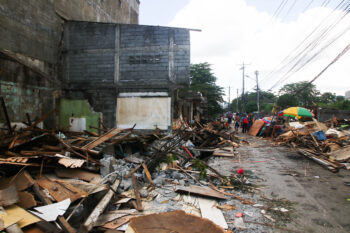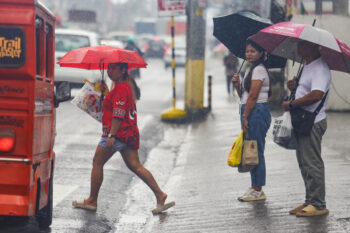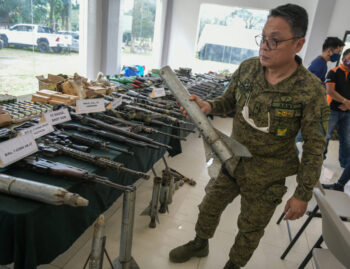
CAGAYAN DE ORO CITY (MindaNews / 01 January) — The year 2023 ended with tropical cyclone Kabayan (Jelawat) dumping torrential rains on Mindanao’s Pacific seaboard before it crossed Mindanao.
People and communities along Kabayan’s path prepared and braced for impact. Life goes on. In recorded history, the year had the least number of tropical cyclones with 11 (like 1998, 2010), around half of the annual average. Welcome to the New Normal.
Although 2023 entered the year with an extended La Niña (January to March), the feared El Niño in the second half of the year turned into a weak, wetter one. It was not as bad, but then again are warnings that the dry spell could hit us badly from the onset of the new year to May 2024.
Dry, warm air is starting to blow from the Pacific Ocean even as we celebrate the New Year. And climate forecasters predict that because of a strong El Niño, 2024 could be warmest in years.
As the planet’s climate is facing unprecedented changes, dry and wet spells have become two sides of the pendulum. El Niño
Southern Oscillation (ENSO) is the warming of the ocean surface, or above-average sea surface temperatures in the central and eastern tropical Pacific Ocean. It weakens the easterly winds in the equator resulting in below-normal precipitation or rainfall.
La Niña is the opposite. The cooling of the ocean surface temperatures in the central and eastern tropical Pacific Ocean results in stronger easterly winds, causing above-average rainfall in countries like the Philippines, Indonesia, and neighboring countries in the region.
More and more scientific evidence points to the abnormal changes in Pacific Ocean temperatures as a result of climate change and global warming. It is like the ocean thermostat going haywire.
Awareness of these changes in our climate is necessary for people to prepare for the impacts of these changes. From the point of view of governance, it would be about disaster risk reduction and management that is driven by climate change disaster risk assessment and serious Local Climate Change Action Planning (LCCAP).
Generally, communities need to prepare.
Wet to Dry
Climate change is very real in Cagayan de Oro City.
This is evidenced by extreme flooding events. Sendong (Washi) in December 2011 was thought to be a 100-year cycle flood (with the 1916 flood in Cagayan de Oro as reference). In normal times, a flood of Sendong magnitude should happen in the years around 2100.
But that has not been the case. Similar floods happened in December 2012 with typhoon Pablo (Bopha); Vinta (Tembin) in 2017; and Odette (Rai) in 2021.
That is four 100-year cycle floods in only 11 years.
Climate models on Cagayan de Oro are not something to be complacent about. According to the Downscaled climate information for Leyte, and cities of Tacloban, Iloilo, Cagayan de Oro, and Zamboanga, Final Report of USAID Be Secure Project, by Manila Observatory, in the next ten years or so, the city might see a wet and wetter climate. From 2036 up to 2060s, Cagayan de Oro may turn dry and drier.
Feel the heat
Cagayan de Oro heating is so true.
Aside from the urban bloom where heat-producing machines like cars and cooling plants are becoming scarce, the increase in temperature in the city is real. And its impact would not just be on the people, but on agriculture which is sensitive to changes in precipitation.
A year from now, the forecasted temperature rise in the city is 0.9 degrees Celsius. By 2050, Cagayan de Oro’s temperature is predicted to reach the 1.5 degrees Celsius threshold. According to the Paris climate change summit of 2015, at a 1.5 degrees Celsius increase in temperature, there could be irreversible damage to ecosystems and habitats.
Water-Food-Energy Nexus
As an overarching approach, many experts are proposing the Water-Food-Energy nexus as the lens to view climate change responses.
These three closely interrelated themes are vulnerable to climate change. Thus, resources should be poured in to mitigate climate change impacts of floods, landslides on one hand, and droughts on water, agriculture, and power.
Development planners need to focus their minds on how to mitigate these climate change impacts. Neighboring Bukidnon, which is the source of vegetables, poultry, and meat could experience similar impacts.
Thus, with its 50,000 hectares area, plans for climate-proof farms need to be put in place. It would be a long process. The good thing is that there is still time. While the city prepares for floods, landslides, and storm surges, it should start thinking of water conservation.
Water conservation starts with the rehabilitation and protection of our watershed — that should have started 30 years ago. In our agricultural areas, there should be studies and modeling on rainwater harvesting. In urban areas, improved drainage and modeling on the sponge city concept may need to be done.
These initiatives should be started this year so that when the need comes, the technologies and practices are fully gestated.
Urban gardening has shown promise. Aside from increasing the Carbon absorption capacity in the urban areas, urban gardens can be dependable sources of food.
Greenhouse gas emission is another thing that needs to be addressed for rapidly urbanizing Cagayan de Oro City.
The Greenhouse gas emission inventory done by the City Local Environment and Natural Resources Office (CLENRO) in 2023 points to the fact that the biggest source of emission is ‘purchased electricity’ or power outlets supplied by coal and diesel plants comprising 41 percent of the city’s carbon footprint.
Purchased electricity is primarily from houses, buildings, and factories.
The solution to the city’s greenhouse gas emission problem could be found in the problem itself. Houses, buildings, and factories have one thing in common: roofs.
With prices of solar PV panels and inverters now very affordable, converting rooftops into solar power farms could significantly reduce the city’s greenhouse gas emissions.
Cagayan de Oro City may also be leading in this energy transition in Mindanao. The city which once had the biggest on-grid solar power plant with an installed capacity of 1MW in southeast Asia in 2004) (in barangay Indahag) leads in rooftop solar power production. Estimates from local solar power installer Greenergy Solar peg the rooftop solar installed capacity in the city at 4 megawatts and growing. Many of these solar power systems are connected to the power utility Cepalco through net metering.
Transition to rooftop solar does not just contribute to the reduction of the city’s greenhouse gas emission problem. It is also economical as savings from these installations could be anywhere from 30 to 50% of power cost.
The city government is in the final stages of transitioning to solar energy. The plans are already in place, and financing is being worked out.
Indubitably, looking at the environment entails giving weight to climate change impacts. And for communities to be resilient to these impacts, it is important to put in mechanisms that would ensure food and water security, and clean, affordable renewable energy. This way, we can be least assured that our way of life would be protected.
[MindaViews is the opinion section of MindaNews. BenCyrus G. Ellorin is an independent climate and renewable energy campaigner. He advises the local government of Cagayan de Oro City on renewable energy, flood reduction, and climate change. He is a consultant of the Mindanao Renewable Energy Acceleration Coordination Hub (Minreach).]







